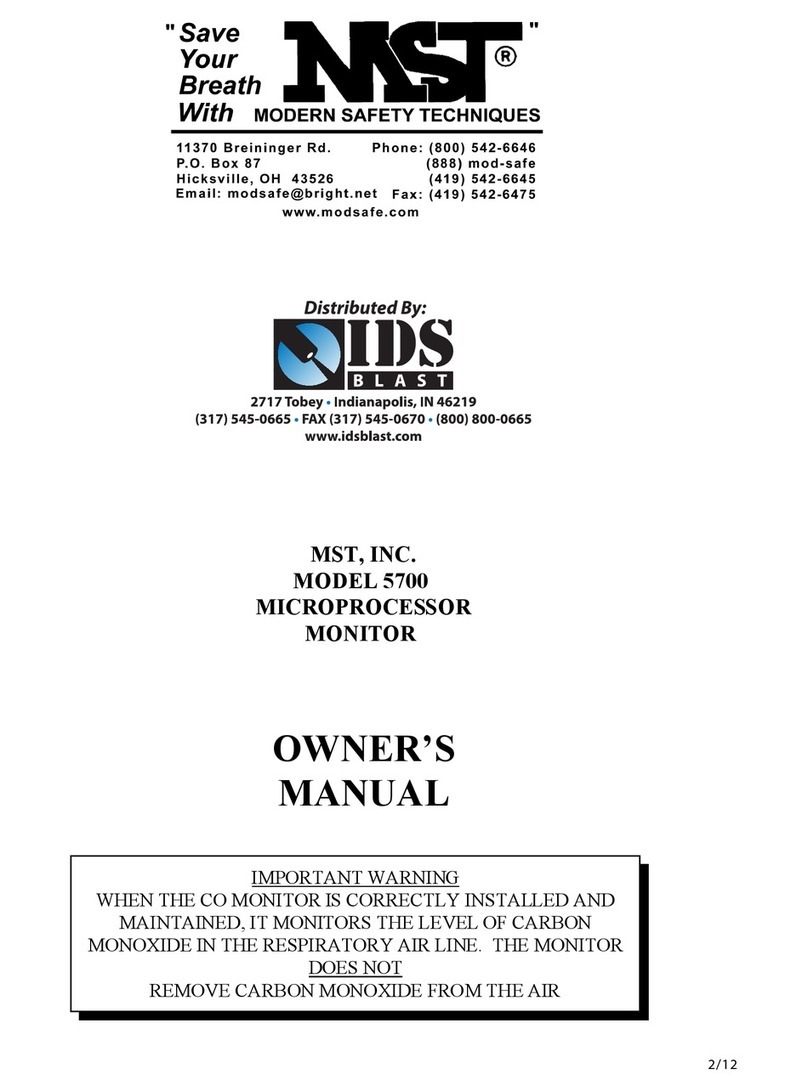
5
GENERAL PURIFICATION SYSTEM DESCRIPTION
TheMST RespiratoryProtector,acompressedbreathingairpurifier,is asystemdesignedto remove
or reduce selected contaminates, includingCarbon Monoxide that is found in standard compressed
air lines. The Respiratory Protector gives you the advantage of connectingdirectlyto shop air from
a standard compressed air source to help provide breathingqualityair to facemasks, helmets, hoods
and other supplied air breathing devices. This eliminates the necessity of providing a separate
breathing air compressor or air supply to your workers.
The Respiratory Protector has a four stage filtration system and a Carbon Monoxide Monitor that
is mounted on a convenient mounting board that allows the unit to be mounted on any available
surface.
SYSTEM DESCRIPTION
(Refer to Figure No. 1 & 2)
Airenteringthe RespiratoryProtector FiltrationSystem at theinlet (A)isusuallycontaminatedwith
oil,water,dirt,rust,scaleandoftendeadlyCarbonMonoxide gas. Astheair passes throughthe First
Stage (B) of the MST Prefilter, particulate matter is trapped and retained. The air then enters the
Second Stage (C) of the Prefilter which coalesces liquid contaminates down to seventy-five
hundredths (0.75) of a micron in size (0.3 micron for particulate matter) with an efficiency ratingof
99.97%(meetsUnderwritersLaboratoriesSpecificationUL586forHighEfficiency,Particulate,Air
FilterUnits). Theliquidcontaminatesaretrappedin thelowerchamberof the prefilter,andexpelled
out of the unit by the Auto Drain. The air entering the Air Scrubber Inlets is 99.97% free of liquid
water and contaminants (down to 0.3 micron in size). The Third Stage (D) of the Air Scrubber
contains an odor absorbing activated charcoal which also collects various gaseous Hydrocarbons
(such as oil fumes, benzene, etc). The Fourth Stage (E) of the Air Scrubber contains a low
temperaturecatalystwhichconvertsCarbonMonoxidegasintoCarbonDioxide.Theuniquecatalyst
alsoconverts orabsorbs Ozone, Nitric Oxide, Sulfur Dioxide, NitrogenDioxide, Hydrogen Sulfide,
Ammonia, Acetaldehyde, Methyl Chloride, Methyl Ethyl Ketone, Acetone, and Methyl Alcohol.
Finally, the air passes through a one (1) micron Filtration Disk at (F). A sample of the filtered air is
taken at (G) and passed through the Carbon Monoxide Monitor. The Carbon Monoxide Monitor
continuously checks the air quality, per OSHA/CSA requirements for Carbon Monoxide, and
digitallydisplays the amount present. An audible alarm will alert operators if any dangerous levels
of Carbon Monoxide exist.





























